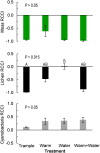Climate change and physical disturbance cause similar community shifts in biological soil crusts
- PMID: 26371310
- PMCID: PMC4593113
- DOI: 10.1073/pnas.1509150112
Climate change and physical disturbance cause similar community shifts in biological soil crusts
Abstract
Biological soil crusts (biocrusts)—communities of mosses, lichens, cyanobacteria, and heterotrophs living at the soil surface—are fundamental components of drylands worldwide, and destruction of biocrusts dramatically alters biogeochemical processes, hydrology, surface energy balance, and vegetation cover. Although there has been long-standing concern over impacts of physical disturbances on biocrusts (e.g., trampling by livestock, damage from vehicles), there is increasing concern over the potential for climate change to alter biocrust community structure. Using long-term data from the Colorado Plateau, we examined the effects of 10 y of experimental warming and altered precipitation (in full-factorial design) on biocrust communities and compared the effects of altered climate with those of long-term physical disturbance (>10 y of replicated human trampling). Surprisingly, altered climate and physical disturbance treatments had similar effects on biocrust community structure. Warming, altered precipitation frequency [an increase of small (1.2 mm) summer rainfall events], and physical disturbance from trampling all promoted early successional community states marked by dramatic declines in moss cover and increases in cyanobacteria cover, with more variable effects on lichens. Although the pace of community change varied significantly among treatments, our results suggest that multiple aspects of climate change will affect biocrusts to the same degree as physical disturbance. This is particularly disconcerting in the context of warming, as temperatures for drylands are projected to increase beyond those imposed as treatments in our study.
Keywords: alternate states; biocrusts; community structure; secondary succession; warming.
Conflict of interest statement
The authors declare no conflict of interest.
Figures




Similar articles
-
Climate change and physical disturbance manipulations result in distinct biological soil crust communities.Appl Environ Microbiol. 2015 Nov;81(21):7448-59. doi: 10.1128/AEM.01443-15. Epub 2015 Aug 14. Appl Environ Microbiol. 2015. PMID: 26276111 Free PMC article.
-
Pathways regulating decreased soil respiration with warming in a biocrust-dominated dryland.Glob Chang Biol. 2018 Oct;24(10):4645-4656. doi: 10.1111/gcb.14399. Epub 2018 Aug 3. Glob Chang Biol. 2018. PMID: 30007104
-
Navigating the possibilities and pitfalls of biocrust recovery in a changing climate.Am J Bot. 2025 Jun;112(6):e70055. doi: 10.1002/ajb2.70055. Epub 2025 Jun 19. Am J Bot. 2025. PMID: 40537990 Review.
-
Mapping biocrust distribution in China's drylands under changing climate.Sci Total Environ. 2023 Dec 20;905:167211. doi: 10.1016/j.scitotenv.2023.167211. Epub 2023 Sep 18. Sci Total Environ. 2023. PMID: 37730025
-
What is a biocrust? A refined, contemporary definition for a broadening research community.Biol Rev Camb Philos Soc. 2022 Oct;97(5):1768-1785. doi: 10.1111/brv.12862. Epub 2022 May 18. Biol Rev Camb Philos Soc. 2022. PMID: 35584903 Free PMC article. Review.
Cited by
-
Soil Chemistry and Nutrients Influence the Distribution of Aerobic Anoxygenic Phototrophic Bacteria and Eukaryotic Phototrophic Microorganisms of Physical Soil Crusts at Different Elevations on the Tibetan Plateau.Microb Ecol. 2022 Jan;83(1):100-113. doi: 10.1007/s00248-021-01734-7. Epub 2021 Mar 17. Microb Ecol. 2022. PMID: 33733304
-
The long-term effect of removing the UV-protectant usnic acid from the thalli of the lichen Cladonia foliacea.Mycol Prog. 2022;21(9):83. doi: 10.1007/s11557-022-01831-y. Epub 2022 Sep 1. Mycol Prog. 2022. PMID: 36065212 Free PMC article.
-
Differential Influences of Wind-Blown Sand Burial on Bacterial and Fungal Communities Inhabiting Biological Soil Crusts in a Temperate Desert, China.Microorganisms. 2022 Oct 11;10(10):2010. doi: 10.3390/microorganisms10102010. Microorganisms. 2022. PMID: 36296286 Free PMC article.
-
Biocrusts increase the resistance to warming-induced increases in topsoil P pools.J Ecol. 2022 Sep;110(9):2074-2087. doi: 10.1111/1365-2745.13930. Epub 2022 Jun 11. J Ecol. 2022. PMID: 36250131 Free PMC article.
-
Water Availability, Soil Characteristics, and Confounding Effects on the Patterns of Biocrust Diversity in the Desert Regions of Northern China.Front Plant Sci. 2022 May 26;13:835668. doi: 10.3389/fpls.2022.835668. eCollection 2022. Front Plant Sci. 2022. PMID: 35720603 Free PMC article.
References
-
- Friedlingstein P, et al. Positive feedback between future climate change and the carbon cycle. Geophys Res Lett. 2001;28(8):1543–1546.
-
- Scheffer M, Carpenter S, Foley JA, Folke C, Walker B. Catastrophic shifts in ecosystems. Nature. 2001;413(6856):591–596. - PubMed
-
- Field CB, Lobell DB, Peters HA, Chiariello NR. Feedbacks of terrestrial ecosystems to climate change. Annu Rev Environ Resour. 2007;32:1–29.
-
- Luo Y. Terrestrial carbon-cycle feedback to climate warming. Annu Rev Ecol Evol Syst. 2007;38:683–712.
-
- Turner MG. Disturbance and landscape dynamics in a changing world. Ecology. 2010;91(10):2833–2849. - PubMed
Publication types
MeSH terms
LinkOut - more resources
Full Text Sources
Other Literature Sources
Medical

